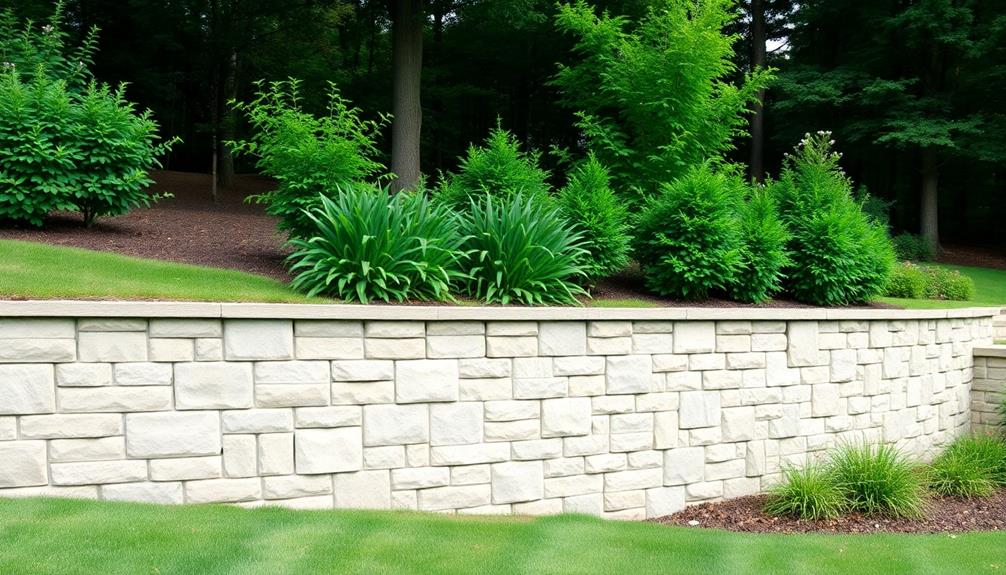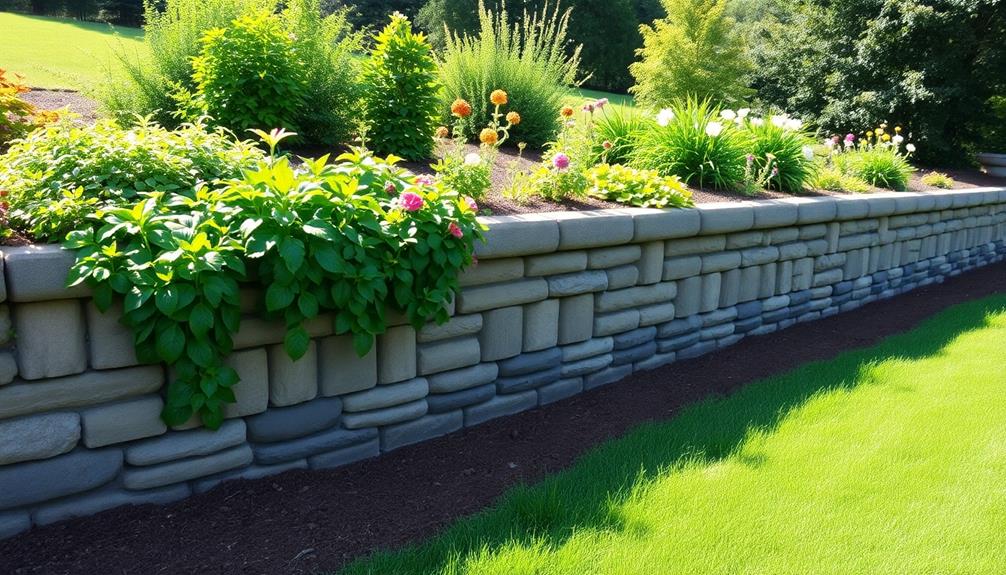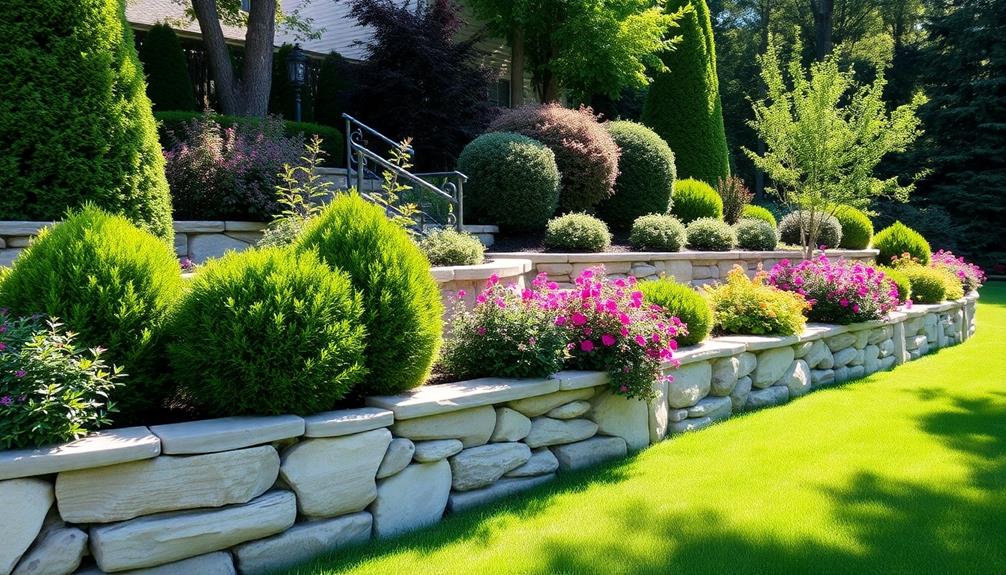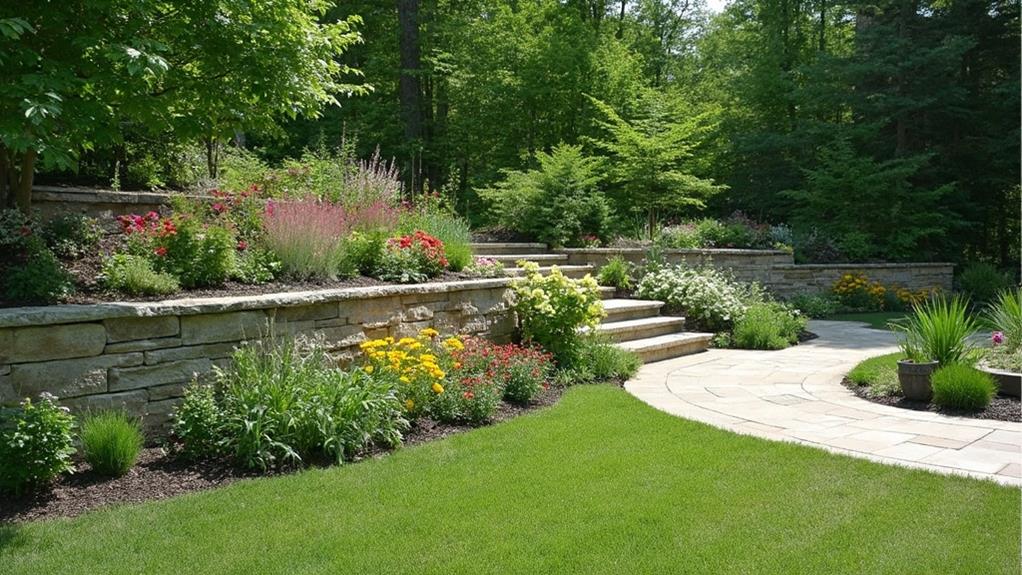Proper maintenance of retaining walls guarantees their stability and extends their lifespan. Employing high-quality materials like reinforced concrete or treated timber is crucial. Regular inspections help identify potential issues, such as cracks or erosion, before they escalate. Effective drainage systems, including perforated pipes, gravel backfill, and strategically placed weep holes, are essential to manage water pressure and prevent structural damage. A proactive maintenance schedule involving surface cleaning, structural inspections, and sealant applications can dramatically reduce repair costs. Adopting these best practices not only enhances safety and functionality but also contributes to maintaining an aesthetically pleasing environment and continued effectiveness.
Table of Contents
ToggleWalls Contractor Highlights
- Conduct regular inspections to identify cracks, bulges, and other structural issues promptly.
- Install effective drainage systems to prevent hydrostatic pressure and ensure proper water management.
- Use high-quality materials, such as reinforced concrete, for increased durability and longevity.
- Schedule regular maintenance, including cleaning and sealant applications, to preserve wall condition.
- Engage professionals for periodic geological assessments and tailored structural solutions.
Definition of Retaining Wall

A retaining wall serves as a vital structural component designed to hold back soil and prevent erosion, typically found in landscapes requiring elevation changes.
Not only does it play an essential role in maintaining the integrity of elevated terrains, but it also creates usable areas perfect for gardening or patios. Constructed using various materials such as concrete, stone, or wood, the choice often depends on the environmental conditions and aesthetic preferences.
Understanding the structural considerations, including load-bearing capacity and drainage requirements, is indispensable for ensuring the wall's long-term effectiveness and stability.
Purpose and Functionality
Retaining walls, essential elements in landscape and structural engineering, serve the pivotal function of holding back soil and preventing erosion on sloped properties. These engineered structures provide stability by countering the lateral pressure exerted by soil, ensuring both aesthetic and functional integrity of landscapes. Retaining walls make perilous topographies usable, allowing for the cultivation of gardens and the creation of terraces that foster communal spaces. They can transform previously unusable or hazardous land into functional areas, promoting safety by mitigating landslide risks.
Beyond their primary purpose, retaining walls support infrastructure developments such as roads, driveways, and building foundations on uneven terrain. By managing water drainage effectively, they prevent soil saturation which could destabilize slope gradients. This drainage functionality is indispensable for the sustainability of landscapes, especially in regions that experience significant rainfalls.
Strategically designed retaining walls enhance the beauty of a landscape by delineating spaces, enabling more organized and purposeful layout planning. In communal settings, they can serve as tiered amphitheaters or seating, bringing communities together in shared environments. These pivotal installations embody a confluence of engineering precision and environmental consideration, offering both practical advantages and aesthetic contributions to their surroundings.
Common Material Types
In understanding the efficacy of retaining walls, it is imperative to ponder the materials used in their construction, each offering unique benefits and suited for various applications. The primary materials include concrete, stone, and wood, each bringing its distinct characteristics to the design and longevity of a retaining wall.
Concrete, highly favored for its strength and durability, allows for a variety of design possibilities, accommodating complex architectural needs with ease. It lends an unparalleled resilience, particularly when reinforced with steel, ensuring stability even under substantial pressure.
Stone, with its natural aesthetics, provides an organic appeal that integrates seamlessly into landscapes. This material offers superior durability and requires minimal maintenance over its lifespan, making it ideal for permanent structures where visual integration is key.
Wood, though less durable compared to stone or concrete, is often chosen for its rustic charm and economic feasibility. It serves well in temporary or low-load applications and can be easily adapted to different site conditions.
Each material type plays a significant role in how effectively a retaining wall serves its purpose of restraining soil, enhancing terrain utility, and contributing to overall landscape design, while requiring specific maintenance practices tailored to its properties.
Structural Considerations
Understanding the foundational role of a retaining wall is essential in the field of construction and landscape design. At their core, retaining walls are indispensable structures designed to hold back soil, preventing erosion and providing support to vertical or near-vertical grade changes in terrain. These functional barriers are not merely decorative; they play a significant role in combating the forces of gravity that could otherwise cause soil instability and land displacement.
In any landscape or construction project, the structural integrity of a retaining wall demands meticulous consideration. This involves selecting appropriate materials—such as concrete, stone, or timber—based on the specific needs of the environment, as well as incorporating effective drainage systems to mitigate hydrostatic pressure, which can compromise stability. While gravity and cantilever walls primarily rely on the weight of the material for stability, anchored walls employ tension to provide additional support, especially in challenging terrains.
Moreover, engineering considerations must include the anticipated load the wall will bear, the soil composition, and environmental factors such as water flow and freeze-thaw cycles. Ensuring these elements are addressed in the design phase promotes longevity and functionality, fostering a sense of community safety and security within development spaces.
Benefits

Effective maintenance of retaining walls offers several significant benefits, including enhancing the structural integrity that is essential for the safety and stability of landscapes. By regularly inspecting and removing any accumulated debris or vegetation, you can guarantee that these structures maintain their visual appeal and functionality.
Additionally, maintenance prevents water damage, a common threat that can compromise wall durability and lead to costly repairs. Furthermore, regular upkeep extends the lifespan of retaining walls, minimizing the need for frequent repairs and thereby reducing long-term maintenance costs.
Enhance Structural Integrity
A well-maintained retaining wall considerably enhances its structural integrity, providing numerous benefits to property owners. A robust wall guarantees stability, preventing the shifting or collapsing that can occur due to soil pressure or external forces. The solid foundation of a properly cared-for retaining wall not only preserves the aesthetic value of the landscape but also furnishes property owners with confidence in the longevity of their infrastructure.
When structural integrity is bolstered through regular maintenance, the wall becomes a reliable guardian against erosion and avalanches of soil, safeguarding homes, gardens, and commercial properties alike.
Moreover, enhanced structural integrity contributes to the long-term cost-effectiveness of a retaining wall by minimizing the need for extensive repairs or replacements. By routinely inspecting and addressing minor issues, property owners can preempt more severe deterioration, consequently ensuring the wall's continued performance. This practice of proactive maintenance cultivates a sense of community among property owners, fostering a shared commitment to sustaining the beauty and functionality of neighborhood infrastructures.
The security offered by a well-maintained retaining wall instills a sense of belonging and peace of mind, knowing that property values and safety are judiciously protected.
Prevent Water Damage
Preventing water damage is essential in maintaining the functionality and longevity of a retaining wall. Water infiltration can compromise the structural stability of these pivotal constructions, leading to erosion and soil displacement that disrupt their intended purpose. By managing water properly, property owners can safeguard against extensive repair costs and preserve the visual and structural appeal of their investments.
Effective drainage solutions, such as installing weep holes and using granular backfill materials, facilitate the unimpeded movement of water away from the wall. This proactive approach averts the buildup of hydrostatic pressure, which is an underlying cause of wall deformation and failure. Including impervious barriers such as geomembranes can further prevent moisture infiltration, enhancing the overall resilience of the structure in varying weather conditions.
Community awareness about the significance of water management can strengthen communal efforts toward protective landscaping and maintenance strategies. As members of a neighborhood that values harmony and stability, property owners should be informed about seasonal risks and adopt annual check-ups to preemptively address potential water-related challenges. Sharing experiences and solutions creates a collective commitment to preserving not only our properties but also the connectedness of our environments. This shared responsibility fosters a sense of belonging through vigilant care.
Increase Lifespan Durability
How can property owners guarantee their retaining walls withstand the test of time? Ensuring the durability of retaining walls involves a multifaceted approach that emphasizes quality materials, effective design, and strategic placement.
Initially, selecting high-quality materials—such as reinforced concrete, interlocking blocks, or treated timber—can greatly enhance longevity. These materials provide greater resilience against the forces of weathering and erosion. The design also plays an integral role; engineering considerations, like proper drainage systems, can prevent water accumulation, which otherwise may compromise structural integrity over time.
Regular inspections are pivotal in identifying signs of wear and potential structural weaknesses early. Property owners benefit from collaborating with professionals skilled in geological assessments to ensure the wall is designed to accommodate the specific soil and slope characteristics of the location. Additionally, a proactive maintenance schedule, which includes cleaning, checking for cracks, and applying sealants or protective coatings, extends the lifecycle of the walls.
Community members who take these steps foster an environment of collective vigilance and pride, showcasing structures that not only stand firm but contribute to the overall aesthetic and functional value of shared residential or commercial spaces. Investing in such robust and enduring solutions fortifies community bonds through shared commitment to excellence.
Minimize Repair Costs
Effectively minimizing repair costs is a pivotal benefit of proper retaining wall maintenance and design. By implementing routine inspections and addressing minor issues promptly, owners can prevent the escalation of minor problems into costly repairs, fostering a sense of security and community trust.
Preventative Maintenance: Regularly scheduled inspections can identify and remedy potential issues before they develop into substantial problems, thus avoiding expensive repairs and preserving the property's aesthetics and structural integrity.
Efficient Resource Use: By ensuring optimal drainage and checking for materials' wear and tear, property managers can extend the lifecycle of retaining wall structures, therefore, maximizing the investment and demonstrating responsible stewardship to their community.
Reduced Emergency Costs: Proactive care reduces the likelihood of emergency repairs, which are typically more expensive and disruptive. Swift identification and resolution of problems can significantly lower financial burdens while maintaining community cohesion and satisfaction.
Adopting these practices not only minimizes repair expenses but also aligns with a community-focused approach that values sustainability and long-term effectiveness. By collectively embracing these strategies, communities can feel assured in the knowledge that their environment remains safe, stable, and attractive, reinforcing a strong sense of belonging among its members.
Expert Maintenance Tips Included

In maintaining the integrity and aesthetic of a retaining wall, there are various expert tips to consider, beginning with the right tools for maintenance and moving through extensive seasonal inspection practices to crucial drainage solutions. A successful maintenance routine empowers property owners to uphold their investment with diligence and foresight. Below is a structured guide detailing essential components vital for retaining wall upkeep:
| Essential Tools | Seasonal Inspection Checklist |
|---|---|
| Shovel | Check for cracks or bulges |
| Spirit level | Inspect drainage outlets |
| Tamping tool | Look for signs of erosion |
| Garden hose | Evaluate vegetation growth |
| Protective gloves | Assess wall alignment |
Essential Tools for Maintenance
Maintaining a retaining wall requires a well-chosen collection of essential tools that guarantee both functionality and longevity. An investment in the right tools not only safeguards your wall but also provides a sense of assurance that regular maintenance can address various issues before they escalate.
Achieving this level of security involves three indispensable tools:
- Masonry Hammer and Chisel: These are pivotal for removing loose or damaged stones or bricks, thus allowing for proper repair without compromising the wall's structural integrity. Precision and care with these tools can rejuvenate your wall's appearance and stability.
- High-Pressure Washer: Dirt, mildew, and efflorescence can accumulate over time, tarnishing the wall's surface. A high-pressure washer effectively cleans these elements, reviving the wall's aesthetic appeal and preventing long-term damage caused by organic growth or mineral deposits.
- Drainage Equipment: Poor drainage remains the arch-nemesis of retaining walls. Tools like trenchers and gravel guarantee effective water diversion, safeguarding the wall from hydrostatic pressure that could lead to catastrophic failures.
These tools, when used with expertise and care, elevate the sense of unity and purpose for those who are responsible for the maintenance of pivotal infrastructures within their communities.
Seasonal Inspection Checklist
A robust approach to retaining wall upkeep not only involves having the right tools but also conducting regular inspections throughout the year to guarantee consistent performance and structural integrity. A comprehensive seasonal inspection checklist fosters a proactive maintenance culture, ultimately extending the lifespan of retaining structures.
Key elements within this checklist include evaluating visible cracks or bulges, which may indicate shifts in soil pressure or underlying structural issues. Additionally, attention to joint disintegration or discoloration ensures timely intervention and repair.
During winter, inspect for erosion hotspots where water accumulation could compromise wall stability; addressing these early can prevent expensive repairs. Springtime should focus on growth of vegetation that might undermine the wall's integrity.
Summer inspections allow for ensuring no heat-induced expansion damages, while autumn guidelines involve clearing leaf debris, particularly from drain outlets to avert blockage.
Equally important is to check wall alignment using tools like plumb lines to identify any lateral displacement. Thorough documentation during each inspection empowers you to offer a detailed history, fostering an engaged community of practice and esprit de corps. Each member benefits from shared knowledge, contributing to a collective commitment towards exemplary retaining wall maintenance.
Effective Drainage Solutions
Effective drainage solutions are paramount for safeguarding the durability and stability of retaining walls. Properly managing water flow is critical to preventing soil erosion and structural damage, thereby shielding your investment. An effective drainage system involves a thoughtful integration of design and maintenance, ensuring the wall can withstand the inevitable challenges posed by water accumulation and soil pressure.
Installing perforated drainage pipes behind the wall directs accumulated water away from the structure. This minimizes pressure and prevents waterlogging, thus maintaining stability.
Incorporating a layer of gravel behind the wall enhances permeability, allowing water to percolate and drain efficiently. This practice mitigates hydrostatic pressure—a common culprit in wall failure.
These small openings at the base of retaining walls facilitate the escape of water, preventing excessive accumulation. Regular inspection and cleaning of weep holes safeguard their unobstructed and functional state.
These drainage strategies, integral to successful retaining wall maintenance, foster a sense of security and belonging as they prolong the life of these man-made structures that protect and enhance our spaces. Proper implementation and upkeep serve as a documentation of responsible property stewardship.
Walls Contractor FAQ
What Are Common Signs of Retaining Wall Failure?
Common signs of retaining wall failure include tilting or bulging structures, noticeable cracks or gaps, water seepage through joints, soil erosion at the base, and displaced wall segments. Addressing these issues promptly fosters community safety and structural resilience.
How Often Should a Retaining Wall Be Inspected?
A retaining wall should ideally be inspected annually to guarantee structural integrity and safety. Regular inspections help identify potential issues early, fostering a sense of security and community by maintaining a safe environment for all stakeholders.
What Materials Are Best for Retaining Wall Longevity?
Selecting materials for retaining wall longevity involves prioritizing durability and environmental resilience. Concrete blocks, natural stone, and reinforced soil structures are preferred due to their robustness and adaptability, ensuring long-term stability and a sense of enduring community investment.
How Can Plants Affect Retaining Wall Maintenance?
Plants can substantially impact retaining wall maintenance by stabilizing soil, reducing erosion, and improving water drainage. However, root systems must be carefully managed to prevent structural damage, ensuring the wall remains functional and aesthetically pleasing for the community.
Are There Specific Weather Conditions Impacting Retaining Wall Durability?
Specific weather conditions, such as heavy rainfall, frost, and extreme temperature fluctuations, can markedly impact retaining wall durability. Proper drainage and regular inspections are essential for maintaining structural integrity, providing reassurance and peace of mind to communities and stakeholders.







